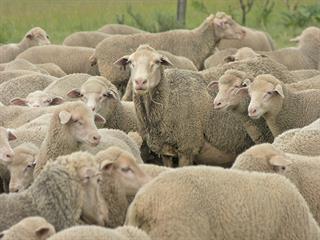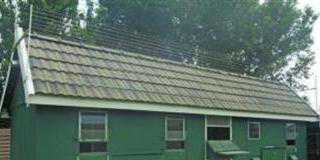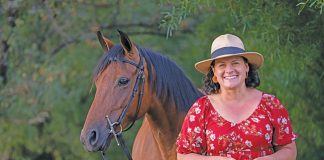
For Deemie Blaine, founder of the Wauldby Dohne Merino Stud near Stutterheim, breeding and rearing Dohne Merinos on the predominantly sourveld of the area was nothing less than a passion. Both his son, Tony, and grandson, Robbie, have continued this tradition, aiming to produce the hardiest, most adapted sheep possible.
“We aren’t in it for a quick buck,’’ says Robbie. “We like to think of ourselves as being in it as a service to the commercial breeder and it must be a long-term commitment.’’
Farming the Wauldby Dohnes on the Eastern Cape’s Amabele sourveld has its challenges, including exceptionally heavy loads of wireworm (Haemonchus contortus), but there simply is no alternative, says Robbie.
“We must use our natural veld here,’’ he says. “If you have mainly maize residue then your stock must be suited to maize residue and if you have wheat lands then your animals must perform off wheat lands, but here we need our stock to perform off the veld.’’
Building the stud
It was with mixed feelings that Deemie decided in the late 1940s to transform his Merino flock into the yet untested Dohne Merino then being developed at the nearby Dohne Research Institute near Stutterheim. The idea was to develop a hardy breed that could combine fine wool production with improved carcass capabilities on the sourveld.

Robbie Blaine will market these Wauldby Dohne Merino rams at his 2016 production sale on 13 March. (Courtesy of the Blaine family)
Since that decision, the Blaine family have more or less become synonymous with the breed. Deemie was part of the action group that launched the Dohne Merino Breed Society (DMBS) in 1966, while Tony was honorary assistant secretary for the council at the society’s inaugural meeting. Tony went on to serve on the council for 17 years, mainly as vice-president. When he died unexpectedly in 1989, Robbie was left at the helm of the Dohne Merino legacy. He recalls how valuable his father’s meticulously-kept diaries containing detailed management procedures proved to be.
Nevertheless, in time Robbie would become as influential in the Dohne fraternity as his father and grandfather and served as an executive committee member of the DMBS for over 20 years. Over the years, he has been closely involved in group breeding initiatives such as the Eastern Dohne Central Nucleus Stud and Sire Reference Scheme. In 1993, Robbie was awarded the Top Dohne Breeder award for the East Cape region and in 1998 the Wauldby Dohne Merino Stud became one of the first to send embryos to Australia.
Today, Robbie farms on almost 2 000ha with a stud flock of 330 ewes and a commercial flock of 1 200 ewes, as well as a herd of Shorthorn cattle.
Wireworm menace
The frost-free climate in the Amabele area, coupled with high humidity and rainfall (750mm to 850mm per annum), means that the sweeter, lower-lying areas of Robbie’s properties is virulent heartwater veld, while the well-grassed higher areas constitute predominantly sourveld with a significant wireworm challenge.
The Blaines had always treated wireworm by dosing the flock approximately every six weeks, which inadvertently allowed the wireworm to develop resistance to the anthelmintics being used (this was before the recent introduction of the active ingredients, Derquantel and Monopantel).
The highly resistant wireworm strain called the ‘Stutterheim strain’ became a grave concern for Robbie, when a leading vet told him in 2006 that he would be unable to farm sheep on Amabele within a decade. However, because the anthelmintics being used had been ineffective for so long, the Wauldby Dohnes also began developing an innate natural resistance and resilience to wireworm.
“I was dosing, thinking I was helping my animals, but I was in effect dosing water, so without realising it my sheep were selecting to become resistant to the parasites,’’ he explains.
In 2010, Robbie therefore became part of a long- term trial in partnership with Dr Alan Fisher (Queenstown Provincial Veterinary Laboratory) and Dr Gretha Snyman (Grootfontein Agricultural Development Institute) to research practical and effective ways to select a highly wireworm-resistant/resilient line of sheep in the Wauldby stud.
The trial was based on the already established fact that the heritability of the traits of resistance and resilience to parasites within sheep had been proven elsewhere in the world, including in the NEMESIS project that commenced in Australia in 1994.
Wireworm- resistant sheep
In 2010, Fisher began to individually record weaned stud lambs (ewes and rams separated) for FAMACHA scores. The latter, a parasite monitoring system, uses an eye chart test to diagnose the level of anaemia and presence of wireworm. A body condition score (BCS) and faecal egg count (FEC) were also determined.
This data was collected every two weeks until the end of July to identify which sheep showed signs of resistance/resilience to wireworm and which needed treatment (sheep that would eventually be culled) to select the most resistant young ram lambs and maiden ewes for mating at 18 months. This data has been collected annually since 2010 from weaned stud lambs over a seven- to eight-month period from weaning to winter.
A number of indices were developed using the average FAMACHA [FAM], BCS, FEC scores of each sampling date while a selection index was based on the average FAM/average BCS/average FEC for the duration of the weaned lambs first summer.
Then FAM + BCS + FEC (equal weights were awarded to each trait, as heritability of these traits is similar – 0,2 to 0,25) was calculated on a natural log transformation which allowed ewes and rams to be ranked in terms of resistance and resilience – as per the selection index. Only lambs that showed a combination of a FAM score of 2,5 or more and a BCS of 1,5 or less considered in conjunction with extremely high FEC were dosed and marked for future culling, while comparisons were made between resistant/resilient sheep that needed no dosing and those that needed treatment.
Flock sires were evaluated on the data of their offspring while various correlations between FEC, growth, body weight, fleece weight and even fibre diameter were measured. Estimated breeding values (EBVs) for FEC (ewes and rams) were also calculated, while about 1 000 blood samples were drawn from lambs showing good, medium and poor resistance/resilience to wireworm, to begin a process of genomic sequencing that will allow for the identification of the genes responsible for resistance and resilience in the flock.
“In the long run, when a lamb is born, you’ll be able to take blood from it and be able to tell if it has the potential to be a resistant lamb or not,’’ explains Robbie.
Over the past five years the results of the trial have shown that resistance to wireworm is clearly heritable within the Wauldby flock and that different sires produced significantly different results in terms of their offspring’s resistance/resilience to wireworm. For example, among the 2014 lambs bred from eight selected sires, 77% of one sire’s lambs needed no dosing, while 15% were dosed once and 8% were dosed twice. In comparison, 52% of another sire’s lambs needed no dosing while 37% were dosed once and 11% were dosed twice.
Furthermore, in 2012 a total of 43% of all lambs, 56% in 2013 and 46% in 2014, needed no dosing throughout the entire trial period. The study also showed that resistant/resilient sheep that were not dosed, on average performed better than dosed sheep. For example, on average, sheep that required dosing remained more anaemic and in poorer body condition than non-dosed sheep while, on average, dosed sheep had higher FEC than non-dosed sheep despite dosing. (Resilient sheep can also have high FEC, however. See box: Resistance vs Resilience.)
In addition, dosed sheep had, on average, considerably lower growth rates, and produced lighter, finer-micron fleeces than non-dosed sheep. Moreover, dosing the sheep added to Robbie’s input costs, with no return on investment.
Breeding and marketing
Today, the Wauldby stud breeding strategy is therefore all about selecting and breeding sheep with the highest levels of resistance/resilience to wireworm – an approach that has revolutionised Robbie’s farming.
“You can’t do anything without any scientific research. Here we have figures for every two weeks over an eight-month period every year for five years,’’ says Robbie. “The ultimate goal is to have sheep you don’t dose at all.’’
For example, 120 of the most resistant of the 330 stud ewes are currently being put to the most resistant rams in the flock. All stud ewes lamb on the veld in August – achieving a lambing rate of between 110% and 115% – before being drafted onto 27ha of pasture (a ryegrass/oats mixture). Commercial ewes that receive no supplementation at all lamb on the veld in an autumn and spring lambing season, producing lambs sired by selected wireworm- resistant/resilient rams.
The Wauldby Dohne Merino Stud has always supplied top stud rams to breeders countrywide. However, in March 2015, the stud raised the bar and made history by becoming the first sheep stud in South Africa to supply rams at a production sale with an EBV for FEC.
A considerable premium was paid for rams – which had never been dosed – with negative EBVs (lower FEC). All 35 rams on offer were sold for an average price of R6 694 while the highest-priced ram (R15 000) was sold to 2012 SA Toyota Young Farmer of the year, Richard Morgan, from Adelaide in the Eastern Cape. Robbie also sold 150 mature dry ewes and 50 maiden ewes on the production sale.
In addition to the rams marketed at his production sale, Robbie sells an extra 70 rams from the farm each year. These are almost all sold to developing farmers looking for hardy veld-adapted rams to be used in the communal areas of the former Ciskei and Transkei.
Helping others
Robbie, who speaks fluent isiXhosa, always takes extra time to share his knowledge and experience with these farmers and speaks at various farmers’ days in the region. He recently received an award from SA Stud Book for his work.
The fact that the Wauldby Dohne Merino Stud’s resistance and resilience to wireworm is improving and that both Robbie’s sons, Bruce and Rex, are keen to return to the farm means that one of South Africa’s great sheep studs will remain a prominent enterprise in the Amabele area for years to come.
Sources: Fisher A. (Queenstown Provincial Veterinary Laboratory) and Snyman M.A. (Grootfontein Agricultural. Development Institute). ‘Practical Breeding for sheep resistance and resilience’; Snyman M.A. (comp). ‘Selection of sheep for Haemonchus Resistance/Resilience’. Report 2011-2014 – ‘Born Lambs’; www.dohnemerino.com.
Phone Robbie Blaine on 043 7820 623 or email [email protected].













